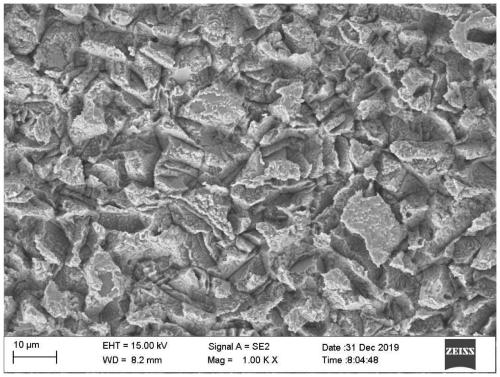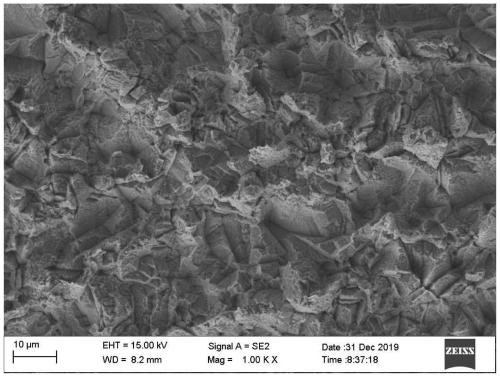Method for preparing super-hydrophobic surfaces of electrolytic copper matrixes
A technology of superhydrophobic surface and copper substrate, applied in the field of electrochemistry, can solve the problems of poor stability of superhydrophobic surface and complicated process, and achieve the effects of environmental friendliness, simple preparation process and short time consumption.
- Summary
- Abstract
- Description
- Claims
- Application Information
AI Technical Summary
Problems solved by technology
Method used
Image
Examples
Embodiment 1
[0019] Step 1: Polish two copper substrates with a size of 50mm×10mm×1mm sequentially with 800, 1500 and 3000 mesh water sandpaper until the surface is smooth, so as to remove the oxide layer on the surface of the copper substrate. Then the polished copper substrate is rinsed with deionized water and absolute ethanol in turn, and placed in a vacuum drying oven with a temperature environment of 50 degrees Celsius to dry for use;
[0020] Step 2. Dissolve 47.54g of nickel chloride hexahydrate and 14.9g of potassium chloride powder in deionized water, set the volume to 200mL, and stir well to obtain a concentration of nickel chloride of 1mol / L and a concentration of potassium chloride of 1mol / L. the electrolyte;
[0021] Step 3: Place the electrolyte solution described in step 2 in the electrolytic cell, connect the two copper substrates dried in step 1 as the anode and the cathode to the positive and negative poles of the programmable DC power supply, and adjust the two copper s...
Embodiment 2
[0025] Step 1: Polish two copper substrates with a size of 50mm×10mm×1mm sequentially with 800, 1500 and 3000 mesh water sandpaper until the surface is smooth, so as to remove the oxide layer on the surface of the copper substrate. Then the polished copper substrate is rinsed with deionized water and absolute ethanol in turn, and placed in a vacuum drying oven with a temperature environment of 50 degrees Celsius to dry for use;
[0026] Step 2. Dissolve 33.28g of nickel chloride hexahydrate and 10.43g of potassium chloride powder in deionized water, set the volume to 200mL, and stir evenly to obtain a nickel chloride concentration of 0.7mol / L and a potassium chloride concentration of 0.7mol / L electrolyte;
[0027] Step 3: Place the electrolyte solution described in step 2 in the electrolytic cell, connect the two copper substrates dried in step 1 as the anode and the cathode to the positive and negative poles of the programmable DC power supply, and adjust the two copper subs...
Embodiment 3
[0030] Step 1: Polish two copper substrates with a size of 50mm×10mm×1mm sequentially with 800, 1500 and 3000 mesh water sandpaper until the surface is smooth, so as to remove the oxide layer on the surface of the copper substrate. Then the polished copper substrate is rinsed with deionized water and absolute ethanol in turn, and placed in a vacuum drying oven with a temperature environment of 50 degrees Celsius to dry for use;
[0031] Step 2. Dissolve 71.31g of nickel chloride hexahydrate and 22.35g of potassium chloride powder in deionized water, set the volume to 200mL, and stir evenly to obtain a concentration of nickel chloride of 1.5mol / L and a concentration of potassium chloride of 1.5mol / L electrolyte;
[0032] Step 3: Place the electrolyte solution described in step 2 in the electrolytic cell, connect the two copper substrates dried in step 1 as the anode and the cathode to the positive and negative poles of the programmable DC power supply, and adjust the two coppe...
PUM
 Login to View More
Login to View More Abstract
Description
Claims
Application Information
 Login to View More
Login to View More - R&D
- Intellectual Property
- Life Sciences
- Materials
- Tech Scout
- Unparalleled Data Quality
- Higher Quality Content
- 60% Fewer Hallucinations
Browse by: Latest US Patents, China's latest patents, Technical Efficacy Thesaurus, Application Domain, Technology Topic, Popular Technical Reports.
© 2025 PatSnap. All rights reserved.Legal|Privacy policy|Modern Slavery Act Transparency Statement|Sitemap|About US| Contact US: help@patsnap.com


